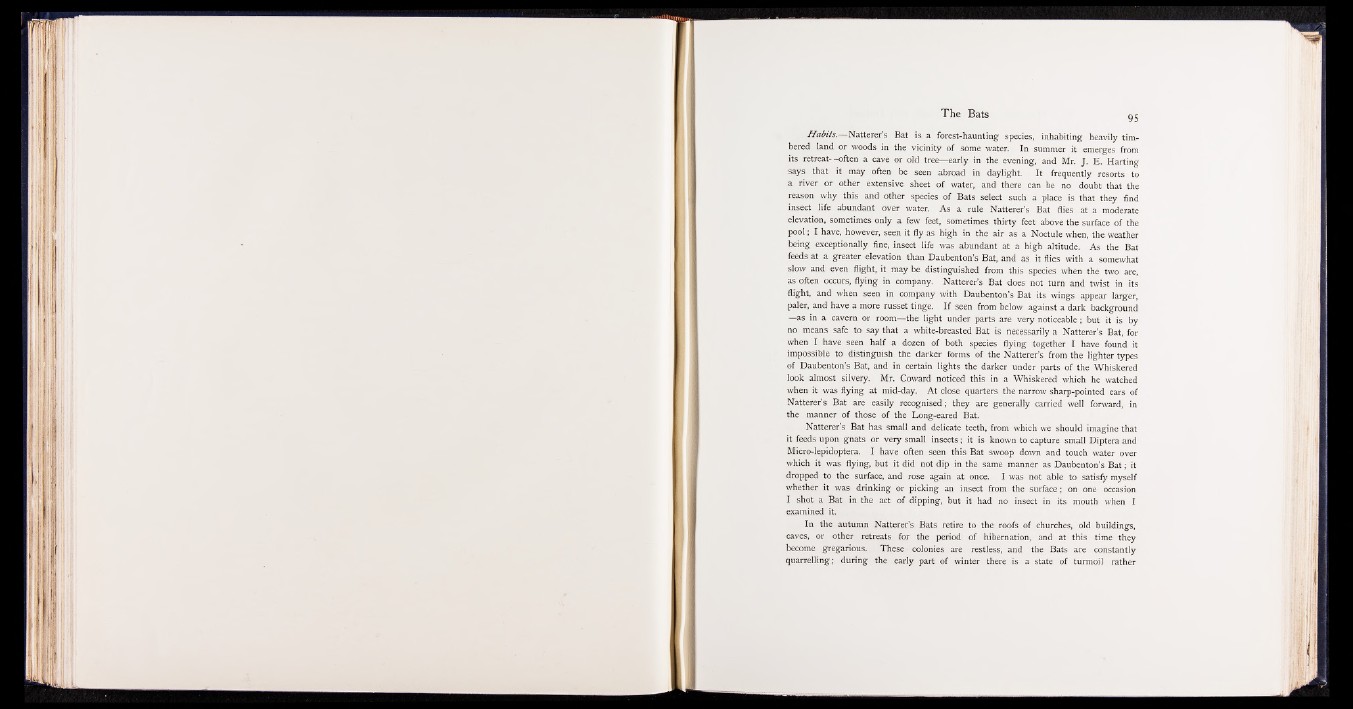
The Bats 9 5
"*W
Habits.— Natterer’s Bat is a forest-haunting species, inhabiting heavily timbered
land or woods in the vicinity of some water. In summer it emerges from
its retreat--often a cave or old tree— early in the evening, and Mr. J. E. Harting
says that it may often be seen abroad in daylight. It frequently resorts to
a river or other extensive sheet of water, and there can be no doubt that the
reason why this and other species of Bats select such a place is that they find
insect life abundant over water. As a rule Natterer’s Bat flies at a moderate
elevation, sometimes only a few feet, sometimes thirty feet above the surface of the
pool; I have, however, seen it fly as high in the air as a Noctule when, the weather
being exceptionally fine, insect life was abundant at a high altitude. As the Bat
feeds at a greater elevation than Daubenton’s Bat, and as it flies with a somewhat
slow and even flight, it may be distinguished from this species when the two are,
as often occurs, flying in company. Natterer’s Bat does not turn and twist in its
flight, and when seen in company with Daubenton’s Bat its wings appear larger,
paler, and have a more russet tinge. I f seen from below against a dark background
—as in a cavern or room— the light under parts are very noticeable; but it is by
no means safe to say that a white-breasted Bat is necessarily a Natterer’s Bat, for
when I have seen half a dozen of both species flying together I have found it
impossible to distinguish the darker forms of the Natterer’s from the lighter types
of Daubenton’s Bat, and in certain lights the darker under parts of the Whiskered
look almost silvery. Mr. Coward noticed this in a Whiskered which he watched
when it was flying at mid-day. At close quarters the narrow sharp-pointed ears of
Natterer’s Bat are easily recognised; they are generally carried well forward, in
the manner of those of the Long-eared Bat.
Natterer’s Bat has small and delicate teeth, from which we should imagine that
it feeds upon gnats or very small insects; it is known to capture small Diptera and
Micro-lepidoptera. I have often seen this Bat swoop down and touch water over
which it was flying, but it did not dip in the same manner as Daubenton’s Bat; it
dropped to the surface, and rose again at once. I was not able to satisfy myself
whether it was drinking or picking an insect from the surface; on one occasion
I shot a Bat in the act of dipping, but it had no insect in its mouth when I
examined it.
In the autumn Natterer’s Bats retire to the roofs of churches, old buildings,
caves, or other retreats for the period of hibernation, and at this time they
become gregarious. These colonies are restless, and the Bats are constantly
quarrelling; during the early part of winter there is a state of turmoil rather